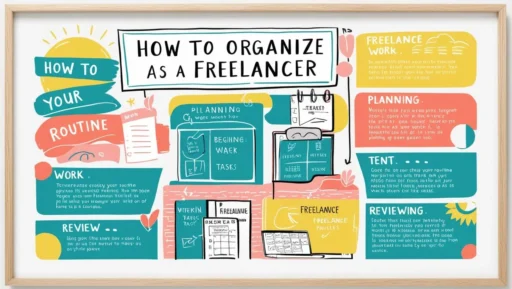Why a Routine is the Secret to Freelance Freedom
One of the greatest promises of the freelance life is the freedom to be your own boss and design your own schedule. No more 9-to-5 grind, no more rush hour commute, no more supervisors dictating your day. However, with this exhilarating freedom comes the profound responsibility of self-management. Without a solid routine, that freedom can quickly devolve into chaos, procrastination, missed deadlines, and crippling burnout.
A well-structured routine is not a rigid cage that stifles creativity; it is the liberating framework that makes true freedom possible. It’s the system that allows you to consistently produce high-quality work, manage client expectations with ease, and, most importantly, protect your time and well-being. This guide provides a comprehensive roadmap for organizing your routine to boost productivity, enhance professionalism, and build a sustainable and enjoyable freelance career.
Step 1: Become a Scientist of Your Own Energy
Before you can structure your day, you must understand your own natural rhythms. Everyone has personal productivity peaks and troughs—times of the day when their focus is sharp and their energy is high, and times when they feel sluggish and distracted. Working with these rhythms, instead of against them, is a game-changer.
- Track Your Energy Levels: For one week, become an observer of your own mind and body. Keep a simple log and, every hour or two, rate your focus, creativity, and energy on a scale of 1 to 5.
- Identify Your “Golden Hours”: By the end of the week, you will see a clear pattern. Are you a “lark” who is most alert from 8 AM to 11 AM? Or are you an “owl” whose creative juices start flowing after 9 PM? These are your “golden hours.”
- Guard Your Golden Hours Fiercely: Schedule your most important, cognitively demanding, and creative work during these peak periods. Protect this time at all costs—no meetings, no emails, no social media. Use your lower-energy times for administrative tasks, responding to emails, or taking well-deserved breaks.
Step 2: From Overwhelm to Action Plan
Staring at a massive to-do list is a recipe for overwhelm and procrastination. A structured goal-setting process breaks down large projects into manageable steps and provides a clear path forward.
- The Weekly Brain Dump: Every Friday afternoon or Monday morning, write down everything you need to accomplish. This includes all client projects, administrative tasks (like invoicing), marketing efforts, and personal appointments. Get it all out of your head and onto paper or a digital list.
- Prioritize with a System: Once you have your master list, prioritize it. A great tool for this is the Eisenhower Matrix, which divides tasks into four quadrants: Urgent & Important, Important but Not Urgent, Urgent but Not Important, and Not Urgent & Not Important. Your focus should be on Quadrant 2: the important but not urgent tasks that drive long-term growth.
- Set Your Daily “Top 3”: At the start of each workday, identify the 1-3 Most Important Tasks (MITs) for that day. These are the tasks that, if completed, will make you feel productive and move the needle on your biggest goals. Tackle these first, before the distractions of the day take over.
Step 3: Design Your Ideal Workday
A daily structure provides discipline and helps create a crucial boundary between your work and personal life.
- Implement Startup and Shutdown Rituals: It’s not just about setting start and end times; it’s about creating rituals. A startup ritual (e.g., getting dressed, making coffee, and reviewing your Top 3 goals) signals to your brain that it’s time to work. A shutdown ritual (e.g., cleaning your desk, planning tomorrow’s tasks, and closing your laptop) helps you mentally disconnect and transition into your personal time.
- Practice Task Batching: Constantly switching between different types of tasks drains your cognitive energy. Instead, group similar activities together and do them in focused blocks.
- The Admin Block: Dedicate one hour to answering all your emails, sending invoices, and handling paperwork.
- The Creative Block: Set aside a 2-3 hour, uninterrupted block for deep, focused creative work.
- The Communication Block: Schedule all your client calls and meetings for a specific afternoon.
- Use Time Blocking: Take task batching a step further by assigning every part of your day to a specific block in your calendar. This includes meetings, deep work, admin tasks, lunch, and even breaks. A time-blocked calendar is a powerful visual plan for your day.
Step 4: Choose Your Organizational Allies
There are countless digital tools that can help you stay organized, but the key is to choose wisely and avoid “tool-hopping.”
- Project Management: For managing client projects with multiple moving parts, tools like Trello, Asana, or ClickUp are invaluable.
- Simple To-Do Lists: For managing your daily tasks, a straightforward app like Todoist or Microsoft To Do is often all you need.
- Time Tracking: To truly understand where your time is going, use a simple time tracker like Toggl or Clockify. The data you gather is crucial for quoting future projects accurately.
Pro Tip: Don’t get caught in the trap of spending more time organizing your organizational system than doing the actual work. Pick a simple system, stick with it for at least a month, and only add complexity when you have a specific problem to solve.
Step 5: Master the Art of Juggling
As your freelance business grows, you’ll need to balance the needs of multiple clients simultaneously.
- Create a Client Dashboard: Use a project management tool or a simple spreadsheet to create a single view where you can see the status, next steps, and deadline for every active project.
- Build in Buffer Time: Freelance life is unpredictable. Always add a 15-20% time buffer to your project estimates. This gives you breathing room to handle unexpected revisions or urgent requests without derailing your entire schedule.
- Protect Your Boundaries: Be honest about how much work you can handle without sacrificing quality. Learn to say “no” politely but firmly. “Thank you so much for this opportunity! My schedule is currently full, but I would be happy to reconnect next month” is a perfectly professional response.
Conclusion: Your Routine is Your Foundation
Organizing your freelance routine is an ongoing process of self-awareness, discipline, and adaptation. The perfect routine is not a static document; it’s a living system that should evolve with you and your business. By taking the time to design and refine your daily structure, you reduce stress, increase your output, and position yourself as a reliable, professional expert. You build the strong foundation required for a long, prosperous, and enjoyable freelance career—one productive day at a time.

